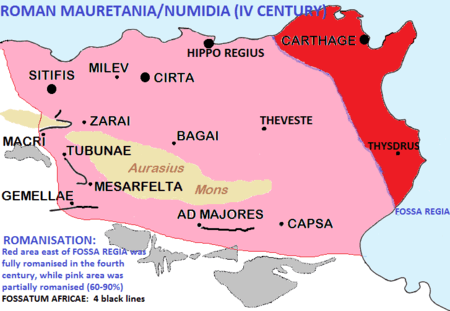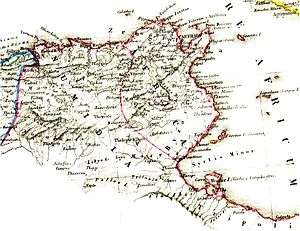Fossa regia
The Fossa regia, also called the Fosse Scipio, was the first part of the Limes Africanus to be built in Africa Proconsulare.

History
Initially, the Fossa regia was used to divide the Berber kingdom of Numidia from the territory of Carthage that was conquered by the Romans in the second century:
"Ea pars quem Africain appellavimus dividitur in duas provincias, veterem ac novam, discretas fossa inter Africanum sequentem et reges Thenas usque perducta". (The region that we call Africa is divided in two provinces, old and new, by a "fossa" (ditch) stretching in Africa from Thenas (near Sfax) until the Thabarca area). Plinius, Historia Naturalis, V, 25
The Fossa was an irregular ditch "from Thabraca on the northern coast to Thaenae on the south-eastern coast"[1] dug by the Romans after their final conquest of Carthage at the end of the Third Punic War in 146 BC. The construction's primary purpose was administrative, not military. It delineated the limits of the newly created Roman province of Africa marking the border between the Roman Republic and its then ally Numidia.[2]

After 46 BC, the western part of the Fossa regia served as the boundary between the Province of Nova Africa, to its west, and the province of Africa Vetus to its east. Even after these two provinces were merged into Proconsular Africa in 27 BC, the ditch continued to be maintained as late as the year 74 AD under Vespasian.
East of Fossa regia there was full Latinization of the local society after Trajan. Under Theodosius that area[3] was fully Romanized with one third of the population made of Italic colonists and their descendants, according to historian Theodore Mommsen. The other two thirds were Romanized Berbers, all Christians and nearly all Latin speaking.
At that time, in the fourth century, Romanization continued in the area between Fossa regia and the Fossatum Africae. After Augustus, Roman colonists and descendants made up nearly 20% of the population. They were concentrated around Cirta with surrounding confederated cities and around Thamugadi in the Aures region, while the remaining 80% was made of Berbers of whom only 25% were not fully assimilated and still spoke their autochthonous Berber language. Nearly all of them practised Christianity (and a few even Judaism).
See also
References
- Rives, J. B. (1995). Religion and authority in Roman Carthage: from Augustus to Constantine, p. 18. Clarendon Press. Retrieved 25 October 2013.
- "Tunis – The Fossa Regia", p. 121 American Journal of Archaeology. At Google Books. Retrieved 25 October 2013.
- Camps: "Fossa Regia" (in French)
Bibliography
- G. Di Vita-Evrard: La Fossa Regia et les diocèses d'Afrique proconsulaire. In: A. Mastino (Hrsg.): L'Africa romana. Atti del III convegno di studio, 1986
- Mommsen, Theodore. The Provinces of the Roman Empire Section: Roman Africa. Ed. Barnes & Noble. New York, 2004